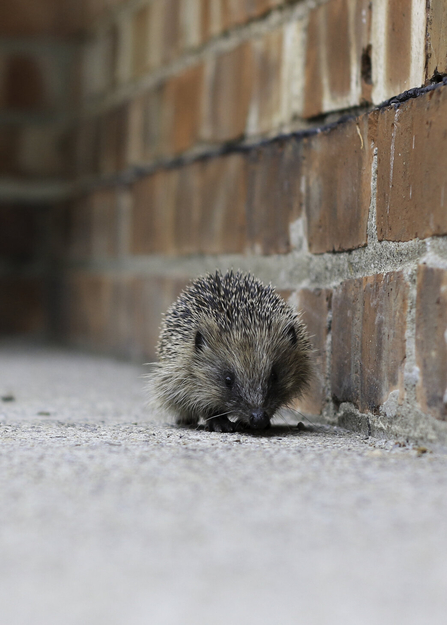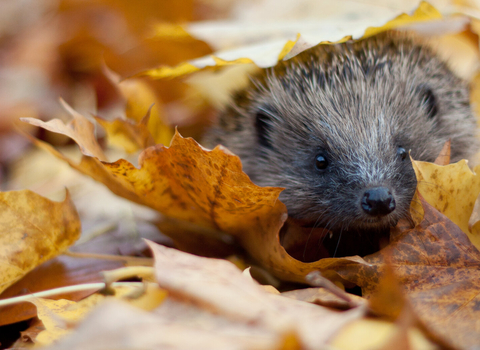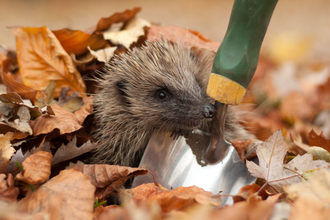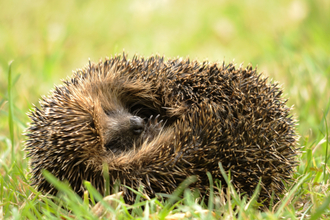A terraced house with a garden encircled by fencing might not be the first place you’d expect to find a hedgehog, but this is exactly where Tiffany – Conservation Assistant for Essex Wildlife Trust – spotted one. Tiffany was so delighted to find a hedgehog in her garden that she created a brilliant video full of tips for making your own outdoor space more hedgehog-friendly. You can watch the video and read all about the importance of hedgehog conservation, below.
How to help hedgehogs in your garden
Hedgehog by Vaughn Matthews
#EssexWildlifeTV - Garden Camera Trap (https://www.youtube.com/watch?v=ibfFgdWiKZY)
Video by Essex Wildlife Trust
Why are hedgehogs important?
Hedgehogs are an ‘indicator species’, meaning a decline in their numbers can tell us a lot about the state of our other nature. For example, hedgehogs feed on invertebrates like slugs, caterpillars and beetles, so a drop in hedgehog numbers could mean these creatures aren’t doing well, either. This in itself will have serious ramifications for a huge number of other creatures, from birds to bats.
Hedgehogs are also incredible pest controllers. They’re often referred to as ‘the gardener’s friend’ because they hoover up all of the bugs and beasties you may want to see less of in your garden. Hedgehogs are a vital part of the ecosystem, keeping invertebrate populations in-check.
Why are hedgehogs declining?
Hedgehogs are declining for a number of reasons: habitat fragmentation, loss of food, intensive farming and urbanisation being the main culprits. Climate change is also having an effect: warmer weather rousing hogs from their winter hibernation more often than normal, before there’s enough food around to sustain them.
Though the problems with modern farming practices, built development and climate change desperately need addressing at a legislative level, the good news is that where habitat fragmentation and food loss are concerned, we can all help!
How can we help hedgehogs in our gardens?

Urban hedgehog by Tom Marshall
Create a hedgehog highway
One of the most important things we can do is to provide holes and access points in our fences and other barriers, so we can link our gardens together for hedgehogs and create a ‘hedgehog highway’. Despite their small size and podgy stature, hogs roam around 2km each night in search of food, mates, nesting areas and hibernation spots. In our increasingly developed landscape this means they need to travel from garden to garden, but they can’t do this when their route is blocked.
Conservation Assistant Tiffany from Essex Wildlife Trust never thought she’d have hedgehogs in her garden because of the fencing, but a couple of strategically placed burrows meant that a hedgehog was able to pop underneath for a much-needed bite to eat. In the video above, Tiffany recommends making a burrow 13cm x 13cm. You could also make a CD-sized hedgehog hole in your fence.
Start an open compost heap
Compost heaps are wonderful homes for all kinds of wildlife, namely insects and invertebrates. These are the things hedgehogs love to eat, so your compost heap will act as a veritable hedgehog buffet! Being made up of things like food waste and grass, plant and shrub cuttings means compost heaps also make perfect hibernation spots and nesting sites for hedgehogs, as well as animals like frogs, toads, slow worms and grass snakes.
Be less tidy in the garden
What could be easier? Log piles, leaf piles and general overgrown areas act in the same way as compost heaps, providing food, shelter and nesting opportunities in one.
Add a pond
If you can, adding a pond will increase the wildlife in your garden tenfold. Ponds are oases for frogs, toads, dragonflies, bees and, yes, even hedgehogs. They’ll stop by to drink from them and are great swimmers, so don’t mind falling in – all they need is a safe route out again. It’s really important to create a pond with a gently sloping side so any unfortunate hedgehogs who do trip into the water can crawl back out again. You could also use rocks or pebbles.

Get 20% off Spike's hedgehog food and invite your hogs to dinner
Invite your hogs to dinner
Hedgehogs feed mainly on invertebrates in the wild, but with their natural food sources dwindling, putting supplementary food in a sheltered spot, at around sunset, can keep them going when times are tough and top up their energy stores.
In the video above, Tiffany used Spike’s Hedgehog Food. This is a specially-formulated hedgehog food which contains all of the nutritious grub that hedgehogs need to be in tip-top health. You could also use meat-based wet cat or dog food, and don’t forget to leave out a bowl of water for thirsty hogs. Water is so important, especially in dry periods when natural water sources dry up.
Remember never to give hedgehogs milk as they’re lactose intolerant and it will make them very poorly.
How to tell if you have hedgehogs in your garden
Now you know how to attract hedgehogs to your garden, how do you tell if they’re actually visiting? Even if the food you leave out is disappearing there’s no guarantee that a hedgehog is the animal eating it, right?
Become a poo detective
There’s one clue that can help rule out creatures like cats, foxes and baders… poo. Hedgehog poo is quite distinctive:
- Between 1.5 – 5cm in length
- Sausage-shaped and may be tapered at one end
- Usually shiny and squidgy
- Normally black in colour
- May contain berry pips and shiny fragments of insect body parts
Set up a trail camera
After finding hedgehog poo in her garden, Tiffany from Essex Wildlife Trust set up a trail camera to see if she could catch her visitor in action. And she did! Tiffany left a bowl of Spike’s Hedgehog Food and a dish of water in front of her wildlife trail camera, and it was soon triggered by the hungry hog who proceeded to munch happily away. You can see Tiffany’s lovely footage in the video above.
One of the best things about trail cameras is that they can help you really get to know your local hedgehog population. The more footage you get, the more you’ll notice certain defining characteristics on each hedgehog and will be able to tell how many different individuals are dropping by. Tiffany noticed that her hedgehog has a mark on its back, so decided to call it Patch.
What should a year in the life of a hedgehog-friendly garden look like?
Hedgehogs only breed and hibernate at certain times of the year, so timing things like feeding and installing a hedgehog house with their internal body clock is important.
November to March
This is when hedgehogs are hibernating, though they may wake up on warmer winter nights to top up their energy stores with a much-needed snack. It’s a good idea to put food and water out on these nights. Once they wake up in March they’ll be extremely hungry and thirsty, so make sure you’re regularly topping up food and water again.
April
Female hedgehogs start scoping out nest sites, making this the perfect month to put out a hedgehog house for the first time. You could also use natural materials like the log piles or leaf piles mentioned earlier to create a safe nesting spot. Don’t worry if your hogs don’t use it for nesting; they may hibernate there later in the year.
May
This is the mating season, so don’t be surprised if you hear some huffing and puffing in your garden! Hedgehogs are very noisy breeders.
June and July
Female hedgehogs usually give birth after four weeks, to a litter of between four and six hoglets which will already have the beginnings of spines. Shortly afterwards, the mother hog will teach them how to forage, and you may find you have a whole family feeding around the bowls of food you leave out.
October
Hedgehogs start scoping out and preparing new hibernation sites, ready to start over again in March.
Your hedgehog sightings
Hedgehogs clashing over food - Mary McAteer (https://youtu.be/Kir_ilwx1G8)
Mary McAteer, Bolton - "I see them almost every night, and have had a family of five in the garden. I've had a few visits from all five, but mainly from one adult with the three youngsters, and then recently, they've all begun to visit individually. I absolutely love having them in the garden. I think they have been hibernating under my shed for the past few winters!"
If you want to learn more about how you can welcome hedgehogs into your garden, click the button below to download our free hedgehog guide. It's packed full of tips for making your garden more hedgehog-friendly, as well as how you can get your local community involved in making the world a safer place for our spiky friends.
If you have pictures or videos of your local hogs, too, we’d love to see them! Click one of the social media icons below to share them with us.









